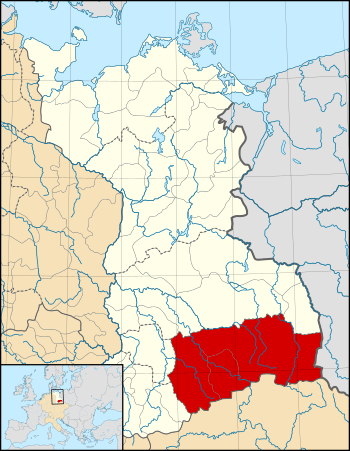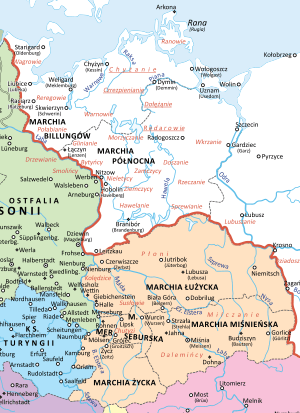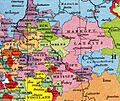Margravate of Meissen facts for kids
|
||||||||||||||||||||||||||||||||||||||||||||||||||||||||
The Margravate of Meissen (German: Markgrafschaft Meißen) was a medieval state in what is now Saxony, Germany. It was like a special border region, called a 'march', of the Holy Roman Empire. It started in 965 from a bigger area called Marca Geronis. A margrave was a ruler of a march, similar to a duke or count.
Under the powerful Wettin family, the Margravate of Meissen grew. By 1423, it joined with the former Duchy of Saxe-Wittenberg to become the Saxon Electorate. This was a very important state in the Holy Roman Empire.
Contents
Early History of Meissen
In the mid-800s, the area that would become Meissen was a border zone. It was part of the Carolingian Empire and known as the Sorbian March. This area was named after the Sorbs, Slavic tribes living beyond the Saale river.
In 849, a leader named Thachulf was called "duke of the Sorbian frontier." Later, these rulers were known as "dukes of the Thuringians." They worked to control the older Duchy of Thuringia to the west.
Around 900 AD, the Sorbian March lost its importance. The last known margrave, Poppo, was removed in 892. The area was then led by others, like Burchard, who was called "margrave of the Thuringians" in 903.
The exact size of this Frankish border area is still debated by historians. It might have reached the lands of the Slavic Glomacze tribes. These lands were often attacked by East Frankish rulers. In 908, Henry the Fowler, a Saxon prince, led campaigns there. By 928/929, the main Glomacze fortress was destroyed. Their lands, up to the Dresden Basin, became part of a larger territory called the Marca Geronis.
How Meissen Was Founded
In 928 and 929, King Henry the Fowler, who became the East Frankish king in 919, built a new fortress. He chose a rock where the Elbe and Triebisch rivers meet. This fortress was named Misni Castle, after the nearby Meisa stream. Later, in the 1400s, it was renamed Albrechtsburg.
A town quickly grew around this new castle. King Henry did not try to force the Slavs to become German. He also did not build many defenses or towns around Meissen. Because of this, Meissen was likely taken over by forces from Bohemia for a short time after 936.
However, the town below the fortress continued to grow. It became one of the most important cities in the huge Marca Geronis. This large area covered the Slavic lands east of the Saxon stem duchy. King Henry and his son, Otto I, kept fighting against the Slavic Milceni tribes. The lands they won were slowly added to the Saxon Eastern March.
When the Marca Geronis was divided in 965, Meissen became the center of a new march. Its main purpose was to control the local Slavic people. The first margrave of Meissen, Wigbert, is mentioned in a document from 968. In the same year, Meissen Castle also became the home of the new Bishopric of Meissen.
In 978, the Saxon count Rikdag became the Margrave of Meissen. He added the marches of Merseburg and Zeitz to Meissen. By 982, the march had grown to the Kwisa river in the east. It also reached the Ore Mountains in the south, sharing a border with the Přemyslid duchy of Bohemia.
Challenges and Growth
In 983, after Emperor Otto II lost a battle, the Slavic Lutici tribes rebelled. This event is known as the Great Slav Rising. New bishoprics like Havelberg and Brandenburg were taken over by the Lutici.
Margrave Rikdag joined forces with other leaders and defeated the Slavs near Stendal. However, many areas of the Northern March were lost. German forces were pushed back to the west of the Elbe river.
In 985, Eckard I became the Margrave of Meissen. His family, the Ekkehardings, held the title until 1046. Eckard worked with Duke Mieszko I of Poland to take back Meissen Castle from Duke Boleslaus II of Bohemia.
When Eckard was killed in 1002, Bolesław I Chrobry, the Polish king, took the chance to conquer lands east of the Elbe. He demanded Meissen surrender. The war that followed ended with the 1018 Peace of Bautzen. Meissen had to give the Milceni region (later Upper Lusatia) to Poland. But in 1031, King Conrad II took back the Milceni lands for Meissen.
In 1046, Count Otto of Weimar-Orlamünde became margrave. After him, Egbert II took over in 1067. Egbert II had a long conflict with Emperor Henry IV. Because of this, he lost the Milceni lands to Duke Vratislaus II of Bohemia in 1076. He was removed from power in 1089.
The Wettin Family Takes Over
Emperor Henry IV then gave Meissen to Count Henry of Eilenburg from the Wettin family. The Wettin family would rule Meissen for the rest of its history.
Under Wiprecht von Groitzsch in the 1120s, Meissen began to become more German. He was followed by important margraves like Conrad the Great (1123–1156), Otto the Rich (1156–1191), and Dietrich the Hard-Pressed (1191–1221). Under their rule, the march grew and developed. Meissen became a strong base for the Wettin family. Even the powerful Hohenstaufen emperors could not take away their power.
In 1264, during the War of the Thuringian Succession, Margrave Henry III gained control of Landgraviate of Thuringia. He also acquired the Pleisseland area around Altenburg. In 1307, King Henry VII tried to control the Margraves of Meissen again. But he was defeated at the Battle of Lucka. By this time, the margravate was almost completely independent.
In the years that followed, several members of the Wettin family often ruled Meissen together. This led to the march being divided in 1382 and 1445. However, it always reunited soon after. Meissen often grew through marriages, purchases, or conquests. This is how it gained the rights to the burgravate in 1426.
End of the Margravate
In 1423, Margrave Frederick IV was given the Duchy of Saxe-Wittenberg by Emperor Sigismund. This was a reward for Frederick's help against the Hussites. The Wettin rulers then became electors of the Holy Roman Empire. They combined their margravial lands into the Saxon Electorate. This meant Meissen was no longer an independent state, but the Wettin rulers still used the title of margrave.
By the late 1400s, the Wettin family controlled a large area between the Werra and Oder rivers. However, in 1485, the Treaty of Leipzig divided these lands again. Frederick's grandsons, Ernest and Albert, split the territory. Ernest ruled in Wittenberg, and Albert took the former Meissen territory. This treaty led to the lasting separation of Saxony and Ernestine Thuringia.
Burgravate of Meissen
Around 1068, Meissen Castle received its own burgrave. A burgrave was a military commander and administrator of a castle and its surrounding district. Over time, the Meinheringer family gained control of this important position.
Images for kids
See also
 In Spanish: Margraviato de Meissen para niños
In Spanish: Margraviato de Meissen para niños









